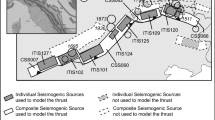Abstract
This study reveals preliminarily the earthquake behavior of variable rupture-scale on active faults of the Chinese mainland, that is that on an individual fault portion earthquake’s rupture-scale varies cycle to cycle, and hence earthquake’s strength changes with time. The tendency of this variation has no necessity. On defining relative size of rupture scales, a statistical result shows that it is of the lowest probability that ruptures with the same scale occur in two successive cycles. While the rupture’s scale in the preceding cycle is “small”, the probability of the following rupture’s scale being "large" is as many as 0.48. While the rupture’s scale in the preceding cycle is "middle", the probability of the succeeding rupture being "small" or "large" scale is 0.69 or 0.25. While the rupture’s scale in the preceding cycle is "large", the probability must be zero for the following rupture with "large" scale, and is 0.36 or 0.64 for the following rupture with "small" or "middle" scale. The author introduces and improves the cascade-rupturing model, and uses it to describe the variability and complexity of rupture scale on individual fault portions. Basic features of some active strike-slip faults on which cascade ruptures have occurred are summarized. Basing on these features the author proposes principles of cascade-rupture segmentation for this type of faults. As an example to application, the author segments one portion of the Anninghe fault zone, western Sichuan, for its future cascade rupture, and further assesses the probable strength and its corresponding probability of the coming earthquake.
Similar content being viewed by others
References
Aki K. 1979. Characterization of barriers on an earthquake fault [J]. J Geophy Res, 84: 6 140–6 148.
DING Guo-yu, TIAN Qin-jian, KONG Fan-chen, et al. 1993. Segmentation of Active Fault: Principles, Methods and Applications [M]. Beijing: Seismological Press, 1–143 (in Chinese).
Department of Earthquake Disaster Prevention, Sate Seismological Bureau ed. 1995. The Catalogue of Chinese Historical Strong Earthquakes (23th century BC-11AD) [R]. Beijing: Seismological Press, 1–514 (in Chinese).
Department of Earthquake Disaster Prevention, China Seismological Bureau ed. 1999. The Catalogue of Chinese Recent Earthquakes (1912 AD–1990 AD) [R]. Beijing: Scientific and Technological Press of China, 1–637 (in Chinese).
FU Zheng-xiang. 1997. Mechanic Study on Seismicity of the Chinese Mainland [M]. Beijing: Seismological Press, 1–294 (in Chinese).
Institute of Geology, State Seismological Bureau, Seismological Bureau of Ningxia Hui Autonomous Region. 1990. The Haiyuan Active Fault Zone [M]. Beijing: Seismological Press, 1–294 (in Chinese).
Institute of Geophysics, SSB, and Institute of Historic Geography of Fudan University eds. 1990a. The Atlas of Historic Earthquakes of China (Volumes for Remote Antiquity to Yuan Dynasties) [M]. Beijing: China Cartographic Publishing House, 1–174 (in Chinese).
Institute of Geophysics, SSB, and Institute of Historic Geography of Fudan University eds. 1990b. The Atlas of Historic Earthquakes of China (Volumes for Ming Dynasty) [M]. Beijing: China Cartographic Publishing House, 1–194 (in Chinese).
Institute of Geophysics, SSB, and Institute of Historic Geography of Fudan University eds. 1990c. The Atlas of Historic Earthquakes of China (Volumes for Qing Dynasty) [M]. Beijing: China Cartographic Publishing House, 1–244 (in Chinese).
LIU Bai-chi. 1987. Characteristic slip behavior along active faults and earthquake sequences of over moderate-strong sizes [J]. Earthquake Research in China, 3(3): 60–67 (in Chinese).
Schwartz D P, Coppersmith K J. 1984. Fault behavior and characteristic earthquakes: Examples from the Wasatch and San Andreas fault zones [J]. J Geophys Res, 90: 5 681–5 698.
Seismological Bureau of Sichuan Province. 1986. The 1981 Daofu Earthquake [M]. Beijing: Seismological Press, 1–77 (in Chinese).
Shimazaki K, Nakata T. 1980. Time-predictable recurrence model for large earthquakes [J]. Geophys Res Lett, 7: 279–282.
Thatcher W. 1990. Order and diversity in the modes of Circum-Pacific earthquake recurrence [J]. J Geophys Res, 95: 2 609–2 623.
WANG Sheng-zu, SHI Liang-qi. 1985. Asperity of sliding zone and two different kinds of sudden instabilities in rocks [J]. Seismology and Geology, 7(3): 73–80 (in Chinese).
Wells D L, Coppersmith K J. 1994. Empirical relationships among magnitude, rupture length, rupture area, and surface displacement [J]. Bull Seismo Soc Amer, 84: 974–1 002.
WEN Xue-ze. 1995. Quantitative Estimates of Seismic Potential on Active Faults [M]. Beijing: Seismological Press, 1–150 (in Chinese).
WEN Xue-ze. 1998a. Assessment of time-dependent seismic hazards on segments of active fault, and its problems [J]. Chinese Science Bulletin, 43: 1 937–1 950.
WEN Xue-ze. 1998b. The uniform-slip method for estimating mean slip-rate of strike-slip faults [J]. Journal of Earthquake Prediction Research, 7(3): 318–328.
WEN Xue-ze. 1999. Recurrence behaviors of segment-rupturing earthquakes on active faults of the China Mainland [J]. Acta Seismologica Sinica, 12(4): 457–465.
WEN Xue-ze. 2000. Character of rupture segmentation of the Xianshuihe-Anninghe-Zemuhe fault zone, western Sichuan [J]. Seismology and Geology, 22(3): 239–249 (in Chinese).
WEN Xue-ze, Allen C R, LUO Zhuo-li, et al. 1990. Segmentation and geometric features of Xianshuihe Holocene fault zone and their seismotectonic implication [J]. Acta Seismologica Sinica, 3(4): 437–452.
WEN Xue-ze, DU Ping-shan, LONG De-xiong. 2000. New evidence of paleoearthquakes and date of the latest event on the Xiaoxiangling mountain segment of the Anninghe fault zone [J]. Seismology and Geology, 22(1): 1–8 (in Chinese).
Working Group on California Earthquake Probabilities. 1995. Seismic hazards in Southern California: probable earthquakes, 1994–2024 [J]. Bull Seismo Soc Amer, 85: 379–439.
Author information
Authors and Affiliations
Additional information
Foundation item: Chinese Joint Seismological Science Foundation (95-07-423).
About this article
Cite this article
Wen, Xz. Earthquake behavior of variable rupture-scale on active faults and application of the cascade-rupturing model. Acta Seimol. Sin. 14, 404–416 (2001). https://doi.org/10.1007/s11589-001-0118-z
Received:
Revised:
Accepted:
Issue Date:
DOI: https://doi.org/10.1007/s11589-001-0118-z




